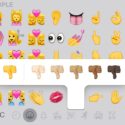Apple seems to love emoji, the Japanese emoticon library, and they’ve played a considerable role in popularizing them outside Japan. I’d like to explore the history and development of emoji in Japan and their spread to the West, but that is quite an undertaking. For now, let’s consider one small aspect of emoji: the weird ones.
We all intuitively “get” what the facial emoji are trying to convey. Just take a look:

Okay, I admit I’m not quite sure when that face mask one would come in handy, but for the most part each of these is pretty clear. But emoji go well beyond little faces: As aficionados know well, there’s a cactus, some leaves, a Hokusai print, a little pile of poop, a dinosaur… Though they’re ambiguous, many of us have found uses for them (sometimes, in fact, because they’re ambiguous).
But there are some emoji we (probably) never, ever use: the ones that just show a Japanese character. For example, you can see some of them here:

For English speakers, these icons have even less communicational utility than a picture of a VHS tape. For Japanese speakers, on the other hand, they do convey something concrete. But when, why and how could they be used? What is the value of using the emoji over just typing the character?
I posed the question to Koichi, creator of a number of innovative Japanese learning tools and arbiter of Japanese culture. It turns out that these icons are handy shortcuts—ways to convey in a single icon what would normally take a few characters. Consider the 申 emoji, for example. Japanese speakers understand it as a shortened form of 申し込み, which means “apply” or “register.” And 祝 is a shorter way to say お祝い, which means “congratulations.” Thus, when under the restraints of time or character limits, or simply to add a bit of style to a message, these emoji can be employed.
Still, they don’t seem to be used that widely. If we take a look at Emoji Tracker, a real-time tracker of emoji use on Twitter, which displays the emoji in order of popularity, we see that the emoji showing Japanese characters fall squarely at the end of the list.
 Follow
Follow
